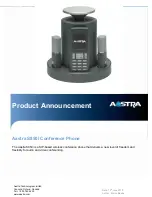
36
Note:
Occasional false alarms do not indicate that the GoSafe Mobile
Button is malfunctioning.
Warning
Do not use the GoSafe Mobile Button if you have an implantable cardiac
device, such as a defibrillator or pacemaker.
Caution
s
In certain situations, the GoSafe Mobile Button may not detect a fall. A
gradual slide from a seated position – such as from a wheelchair – may
not register as a fall and would not be detected.
If you fall and need help,
always press the Help Button if you are able to.
The vent area located on the back of the GoSafe Mobile Button is part of
the fall detection sensor system and needs to remain clear of obstructions
(e.g., lint or food products). A continuous flow of water (e.g., a shower)
hitting the vent directly may also temporarily obstruct the vent. However,
your GoSafe Mobile Button is waterproof and should be worn at all times
– even when bathing or showering.
The GoSafe Mobile Button may interfere with certain medical equipment,
such as magnetic resonance imaging (MRI), X-ray machines, Automatic
External Defibrillators, cardiac monitors, insulin pumps, hearing aides, as
well as metal detectors. It may also interfere with aircraft communications.
Be sure to place your GoSafe Mobile Button in sleep mode when on an
airplane. Please see instructions for putting your GoSafe Mobile Button in
sleep mode on page 38.
The GoSafe Mobile Button can only place a Help Call when it is within the
range of the Home Communicator to which it has been programmed and/
or when the AT&T wireless network is available.
















































